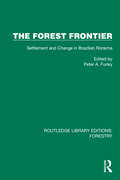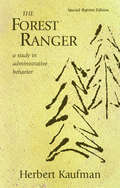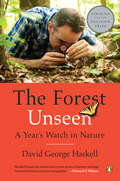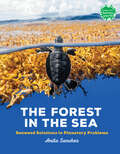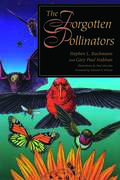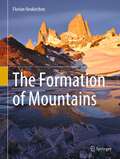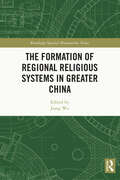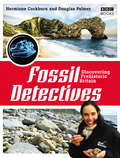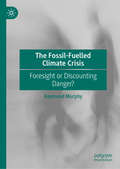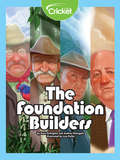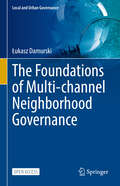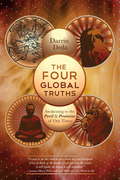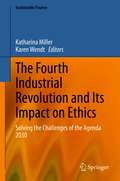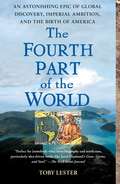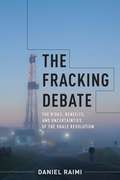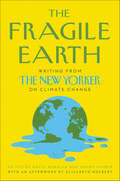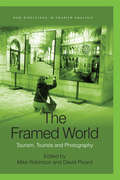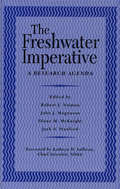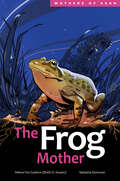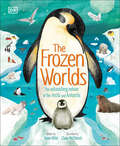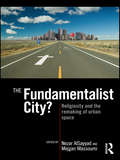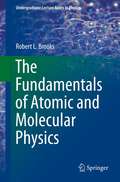- Table View
- List View
The Forest Frontier: Settlement and Change in Brazilian Roraima (Routledge Library Editions: Forestry)
by Peter A. FurleyOriginally published in 1994, this book analysed land developments, deforestation and pasture substitution, colonisation schemes and spontaneous settlement during the latter part of the 20th Century. In so doing, The Forest Frontier presents an overview of the intrinsic environmental and socio-economic resources of the Roraima, the most northerly of the Brazilian Amazon states. Roraima is of special environmental interest because of its extensive savannas and varied forests – the home of some of the largest and most diverse groups of indigenous Indians. This critical assessment of the nature and pace of agricultural advance into Roraima examines the range of strategies which have been proposed to cope with the inevitable development. With the conflict between preserving the natural environment and development still major issues for Brazil, this book remains as relevant now as when it was first published.
The Forest Ranger: A Study in Administrative Behavior
by Herbert KaufmanIt is the rare book that remains in print for nearly fifty years, earning wide acclaim as a classic. The Forest Ranger has been essential reading for generations of professionals and scholars in forestry, public administration, and organizational behavior who are interested in the administration of public lands and how the top managers of a large, dispersed organization with multiple objectives like the Forest Service shape the behavior of its field officers into a coherent, unified program. Published as a special reprint in conjunction with the 100th anniversary of the U.S. Forest Service, The Forest Ranger is as relevant and timely today as when it was first issued in 1960. In addition to the original text, this special reprint of The Forest Ranger includes two new forewords and an afterword that highlight how much we have learned from Herbert Kaufman. The first foreword, by Harold K. (Pete) Steen, former president of the Forest History Society, considers the book's impact on the forestry community and explains its continued relevance in light of changes in the culture and mission of today's Forest Service. The second, by Richard P. Nathan, co-director of the Rockefeller Institute of Government, considers the book's contribution to our understanding of administrative and organizational behavior. A new afterword by author Herbert Kaufman describes how his landmark study came into being and offers a candid assessment of how his theories about the agency's operations and its future have held up over time. In 1960, the Forest Service had a welldeserved reputation for excellence, and The Forest Ranger was a seminal analysis of the how's and why's of its success. Kaufman also warned, however, that an organization so unified and well adapted to its environment would have difficulties navigating social change. He was right in his concerns: The environmental, civil rights, and women's movements have all presented challenges to the character and purpose of the Forest Service, ultimately changing the organization in subtle and not-so-subtle ways. Now, as then, The Forest Ranger is a striking and prescient case study of how a complex organization operates and evolves over time.
The Forest Unseen
by David George HaskellA 2013 Pulitzer Prize Finalist for General Nonfiction Winner of the 2013 Best Book Award from the National Academies A Finalist for the PEN/E.O. Wilson Literary Science Writing Award Winner of the National Outdoor Book Award Winner of the Reed Award from the Southern Environmental Law Center A biologist reveals the secret world hidden in a single square meter of forest Written with remarkable grace and empathy, The Forest Unseen is a grand tour of nature in all its profundity. Biologist David George Haskell uses a one-square-meter patch of old-growth Tennessee forest as a window onto the entire natural world. Visiting it almost daily for one year to trace nature's path through the seasons, he brings the forest and its inhabitants to vivid life. Beginning with simple observations--a salamander scuttling across the leaf litter, the first blossom of spring wildflowers--Haskell spins a brilliant web of biology, ecology, and poetry, explaining the science binding together ecosystems that have cycled for thousands--sometimes millions--of years.
The Forest in the Sea: Seaweed Solutions to Planetary Problems (Books for a Better Earth)
by Anita SanchezMeet an unlikely climate change hero: the wet, slimy stuff known as seaweed.Imagine forests where you can float weightlessly among schools of fish. Huge green pastures where sea turtles graze. Forests that capture carbon from seawater and breathe out oxygen. The answers to many of our planet&’s problems may lie underwater, in these forests of seaweed.Celebrated nonfiction author Anita Sanchez takes readers on a tour of seaweed forests, from the Sargasso Sea to seaweed patches off Prince Edward Island, to explore how seaweed supports marine ecosystems and plays a big role in climate change solutions. From reducing methane emissions to advances in biofuels, medicines, and more, seaweed science is at the forefront of innovation.Written with beauty and wonder, The Forest in the Sea encourages readers to think outside the box when it comes to climate change. Back matter includes recipes, activities, ways to identify and help protect seaweed, and more.Books for a Better Earth are designed to inspire children to become active, knowledgeable participants in caring for the planet they live on.Books for a Better Earth are designed to inspire children to become active, knowledgeable participants in caring for the planet they live on.A Junior Library Guild Gold Standard Selection
The Forgotten Pollinators: Dynamics And Restoration Of Abandoned Farmland
by Gary Paul Nabhan Paul Mirocha Stephen L. BuchmannConsider this: Without interaction between animals and flowering plants, the seeds and fruits that make up nearly eighty percent of the human diet would not exist.In The Forgotten Pollinators, Stephen L. Buchmann, one of the world's leading authorities on bees and pollination, and Gary Paul Nabhan, award-winning writer and renowned crop ecologist, explore the vital but little-appreciated relationship between plants and the animals they depend on for reproduction -- bees, beetles, butterflies, hummingbirds, moths, bats, and countless other animals, some widely recognized and other almost unknown.Scenes from around the globe -- examining island flora and fauna on the Galapagos, counting bees in the Panamanian rain forest, witnessing an ancient honey-hunting ritual in Malaysia -- bring to life the hidden relationships between plants and animals, and demonstrate the ways in which human society affects and is affected by those relationships. Buchmann and Nabhan combine vignettes from the field with expository discussions of ecology, botany, and crop science to present a lively and fascinating account of the ecological and cultural context of plant-pollinator relationships.More than any other natural process, plant-pollinator relationships offer vivid examples of the connections between endangered species and threatened habitats. The authors explain how human-induced changes in pollinator populations -- caused by overuse of chemical pesticides, unbridled development, and conversion of natural areas into monocultural cropland-can have a ripple effect on disparate species, ultimately leading to a "cascade of linked extinctions."
The Formation of Mountains
by Florian NeukirchenMountains as we know them were formed by a wide range of processes. This vivid introduction explains the course of orogeny (mountain formation) and the resulting structures, the cycles of plate tectonics and the evolution of landforms. It also presents surprising findings from the latest research. Popular travel destinations are described in detail – ideal when preparing for a trip – while a wealth of photos and graphics illustrate the text. Why are mountains as tall as they are? How does high-pressure rock come to the surface? Is there feedback between tectonics and the climate? How can mountains form without continental collision, far away from any plate boundaries? And how do we know all this? These and many other questions will be answered.
The Formation of Regional Religious Systems in Greater China (Routledge Spatial Humanities Series)
by Jiang WuThe rise of Spatial Humanities has spurred a digital revolution in the field of Chinese studies, especially in the study of religion. Based on years of data compilation and analysis of religious sites, this book explores the formation of Regional Religious Systems (RRS) in Greater China in unprecedented scope and depth. It addresses quantitatively the enduring historical and contemporary issues of China’s deep-rooted regionalism and spatially variegated cultural and religious landscape. A range of topics are explored: theoretical discussions of the concept of RRS; case studies of regional and local religious institutions; the formation of local cults and pilgrimage network; and the spread of religious networks to overseas Chinese communities and the Bon religion in Tibet. The book also considers long-standing challenges of researching with spatial data for humanities and social science research, such as data collection, integration, spatial analysis, and map creation. This book will be of interest to students and scholars in Religious Studies, Cultural Studies, Chinese Studies, Digital Humanities, Human Geography and Sociology.
The Formation of Vegetable Mould Through The Action of Worms - With Observations on Their Habits
by Charles DarwinThe Fossil Detectives: Discovering Prehistoric Britain
by Douglas Palmer Hermione CockburnFossils provide us with a tantalizing glimpse of Britain's prehistoric past and hold the key to unlocking the secrets of life's history and evolution. Since the appearance of primitive organisms in Britain more than a billion years ago, oceans, deserts, swamps and vast mountains have come and gone in our corner of western Europe; forests of long-extinct trees, flowers and grasses have covered the land, and dinosaurs and other strange creatures have roamed across it. How do we know? The evidence is all around us - in the rocks and fossils that lie beneath the landscape.In this highly informative and practical book, which accompanies the BBC series, presenter Hermione Cockburn and renowned palaeontologist Douglas Palmer take an in-depth look at the most exciting fossil stories from around the country. When and why were dinosaur fossils first discovered in Britain? How was the biggest fish ever to have swum in the sea unearthed near Peterborough? What do modern medical techniques have to offer fossil hunters?Packed with colour photographs and illustrations, Fossils Detectives is full of surprising facts and features. And for those who want to try their hand at some fossil detecting of their own, the book includes an extensive regional gazetteer of fossil-hunting sites and places to visit, and guidance on identifying your fossil finds.Get ready for some time travel around Britain, with the Fossil Detectives!
The Fossil-Fuelled Climate Crisis: Foresight or Discounting Danger?
by Raymond MurphyThis book analyses the threat posed by the continued use of fossil fuels. By utilizing Elizabeth Shove’s social practices approach and Murphy’s own social closure framework, the book examines the accelerating treadmill of carbon-polluting practices. It incorporates externalities theory to investigate how the full cost of fossil fuels is paid by others rather than users, and to demonstrate that the environmental commons is a medium for conveying intergenerational monopolisation and exclusion in the Anthropocene. Murphy uncovers a pattern of opposition to change when exploiting valuable but dangerous resources. He argues that a new faith in mastering nature is emerging as a belief in just-in-time technological solutions to circumvent having to change fossil-fuelled practices.The book then moves on to assess proposed solutions, including Beck’s staging of risk and his hypothesis that the anticipation of global catastrophe will incite emancipation. It proposes a novel approach to enhancing foresight and avoid incubating disaster. It will appeal to readers interested in an original social science analysis of this creeping crisis and its resolution.
The Foundation Builders
by Gina DeAngelisLearn about America's founding conservationists: Theodore Roosevelt, Gifford Pinchot, Stephen T. Mather, Hugh Hammond Bennett.
The Foundations of Multi-channel Neighborhood Governance (Local and Urban Governance)
by Łukasz DamurskiThe book presents various aspects of the current urban development in the context of the recent rapid growth of the ICT sector. It focuses on the local scale, in line with the notion that the neighborhood is the fundamental component of any urban area. Beginning with a critical overview of the urban governance paradigms, through a careful analysis of the multifaceted relationships between the Internet and the urban functions, followed by a description of selected approaches to local urban spatial policy, it concludes with a concept of multi-channel neighborhood governance (MCNG). The key observation is that the accelerating virtualization of urban life has profound consequences for the spatial, social, and economic structures of cities. At the local level, it is changing the functional profile of neighborhoods, replacing some traditional on-site local services with online ones, reducing (or even eliminating) the need for face-to-face social interaction, rejoining work and home roles, and modifying the spatial behaviors of residents. All of this calls for a prompt response from the neighborhood governance, which should include the nonspatial (online) components of contemporary urban lifestyles. The book searches for an alternative to conventional planning, capable of addressing the virtualization of different urban functions at the neighborhood level and providing satisfactory solutions for shaping an optimal balance between online and offline environments. The study defines a comprehensive method for the management of essential services in urban neighborhoods, with special attention to the integration of online and offline channels. The MCNG concept includes a list of recommendations for urban policy practitioners on how to deal with digital conversion, how to manage land use, how to stimulate entrepreneurship, and how to improve quality of life.
The Four Global Truths
by Darrin DrdaWith the planet increasingly threatened with catastrophe and perhaps even collapse, many seekers are looking to past, proven models to create meaningful change in their lives. One such model is Buddhism's Four Noble Truths: the reality of suffering, the root cause of suffering, the end of suffering, and the path to the end of suffering. This fresh, timely book taps and modifies that ancient wisdom to address the pressing environmental and spiritual crises facing us. In The Four Global Truths, author Darrin Drda contends that as global temperatures rise and natural systems decline, humanity is forced to confront the destructiveness of unfettered material progress and mechanistic thinking. He posits a more enlightened worldview that honors the interdependence of all forms of life and aspects of reality, a concept increasingly see as a practical and compassionate approach to averting disaster. Writing in a warm, open style recalling that of Eckhart Tolle in The New Earth, Drda integrates elements of Western philosophy, transpersonal psychology, deep ecology, modern cosmology, and quantum physics to get at the heart of worldwide ecological suffering. In the process he encourages a responsible and joyful--and ultimately healing--participation in this critical moment in life.About the Imprint: EVOLVER EDITIONS promotes a new counterculture that recognizes humanity's visionary potential and takes tangible, pragmatic steps to realize it. EVOLVER EDITIONS explores the dynamics of personal, collective, and global change from a wide range of perspectives. EVOLVER EDITIONS is an imprint of North Atlantic Books and is produced in collaboration with Evolver, LLC.From the Trade Paperback edition.
The Fourth Industrial Revolution and Its Impact on Ethics: Solving the Challenges of the Agenda 2030 (Sustainable Finance)
by Karen Wendt Katharina MillerThis book tackles the ethical problems of the “Fourth Industrial Revolution” (4IR) and offers readers an overview of the ethical challenges connected to Artificial Intelligence (AI), encryption and the finance industry. It specifically focuses on the situation of females in these industries, from women lawyers, judges, attorneys-at-law, investors and bankers, to portfolio managers, solicitors and civil servants. As the 4IR is more than “just” a technology-driven transformation, this book is a call to policymakers and business leaders to harness new technologies in order to create a more inclusive, human-centered future. It offers many practical cases of proactive change agents, and offers solutions to the ethical challenges in connection with implementing revolutionary disruptive products that often eliminate the intermediary. In addition, the book addresses sustainable finance in startups. In this context, education, training, agility and life-long learning in financial literacy are some of the key solutions highlighted here. The respective contributors supply a diverse range of perspectives, so as to promote a multi-stakeholder approach.
The Fourth Part of the World: The Race to the Ends of the Earth, and the Epic Story of the Map That Gave America Its Name
by Toby Lester“Old maps lead you to strange and unexpected places, and none does so more ineluctably than the subject of this book: the giant, beguiling Waldseemüller world map of 1507.” So begins this remarkable story of the map that gave America its name.For millennia Europeans believed that the world consisted of three parts: Europe, Africa, and Asia. They drew the three continents in countless shapes and sizes on their maps, but occasionally they hinted at the existence of a "fourth part of the world," a mysterious, inaccessible place, separated from the rest by a vast expanse of ocean. It was a land of myth—until 1507, that is, when Martin Waldseemüller and Matthias Ringmann, two obscure scholars working in the mountains of eastern France, made it real. Columbus had died the year before convinced that he had sailed to Asia, but Waldseemüller and Ringmann, after reading about the Atlantic discoveries of Columbus’s contemporary Amerigo Vespucci, came to a startling conclusion: Vespucci had reached the fourth part of the world. To celebrate his achievement, Waldseemüller and Ringmann printed a huge map, for the first time showing the New World surrounded by water and distinct from Asia, and in Vespucci’s honor they gave this New World a name: America. The Fourth Part of the World is the story behind that map, a thrilling saga of geographical and intellectual exploration, full of outsize thinkers and voyages. Taking a kaleidoscopic approach, Toby Lester traces the origins of our modern worldview. His narrative sweeps across continents and centuries, zeroing in on different portions of the map to reveal strands of ancient legend, Biblical prophecy, classical learning, medieval exploration, imperial ambitions, and more. In Lester’s telling the map comes alive: Marco Polo and the early Christian missionaries trek across Central Asia and China; Europe’s early humanists travel to monastic libraries to recover ancient texts; Portuguese merchants round up the first West African slaves; Christopher Columbus and Amerigo Vespucci make their epic voyages of discovery; and finally, vitally, Nicholas Copernicus makes an appearance, deducing from the new geography shown on the Waldseemüller map that the earth could not lie at the center of the cosmos. The map literally altered humanity’s worldview. One thousand copies of the map were printed, yet only one remains. Discovered accidentally in 1901 in the library of a German castle it was bought in 2003 for the unprecedented sum of $10 million by the Library of Congress, where it is now on permanent public display. Lavishly illustrated with rare maps and diagrams, The Fourth Part of the World is the story of that map: the dazzling story of the geographical and intellectual journeys that have helped us decipher our world.
The Fracking Debate: The Risks, Benefits, and Uncertainties of the Shale Revolution (Center on Global Energy Policy Series)
by Daniel RaimiOver roughly the past decade, oil and gas production in the United States has surged dramatically—thanks largely to technological advances such as high-volume hydraulic fracturing, more commonly known as “fracking.” This rapid increase has generated widespread debate, with proponents touting economic and energy-security benefits and opponents highlighting the environmental and social risks of increased oil and gas production. Despite the heated debate, neither side has a monopoly on the facts. In this book, Daniel Raimi gives a balanced and accessible view of oil and gas development, clearly and thoroughly explaining the key issues surrounding the shale revolution.The Fracking Debate directly addresses the most common questions and concerns associated with fracking: What is fracking? Does fracking pollute the water supply? Will fracking make the United States energy independent? Does fracking cause earthquakes? How is fracking regulated? Is fracking good for the economy? Coupling a deep understanding of the scholarly research with lessons from his travels to every major U.S. oil- and gas-producing region, Raimi highlights stories of the people and communities affected by the shale revolution, for better and for worse. The Fracking Debate provides the evidence and context that have so frequently been missing from the national discussion of the future of oil and gas production, offering readers the tools to make sense of this critical issue.
The Fragile Earth: Writing from The New Yorker on Climate Change
by Elizabeth KolbertA New York Times New & Noteworthy BookOne of the Daily Beast’s 5 Essential Books to Read Before the ElectionA collection of the New Yorker’s groundbreaking reporting from the front lines of climate change—including writing from Bill McKibben, Elizabeth Kolbert, Ian Frazier, Kathryn Schulz, and moreJust one year after climatologist James Hansen first came before a Senate committee and testified that the Earth was now warmer than it had ever been in recorded history, thanks to humankind’s heedless consumption of fossil fuels, New Yorker writer Bill McKibben published a deeply reported and considered piece on climate change and what it could mean for the planet. At the time, the piece was to some speculative to the point of alarmist; read now, McKibben’s work is heroically prescient. Since then, the New Yorker has devoted enormous attention to climate change, describing the causes of the crisis, the political and ecological conditions we now find ourselves in, and the scenarios and solutions we face. The Fragile Earth tells the story of climate change—its past, present, and future—taking readers from Greenland to the Great Plains, and into both laboratories and rain forests. It features some of the best writing on global warming from the last three decades, including Bill McKibben’s seminal essay “The End of Nature,” the first piece to popularize both the science and politics of climate change for a general audience, and the Pulitzer Prize–winning work of Elizabeth Kolbert, as well as Kathryn Schulz, Dexter Filkins, Jonathan Franzen, Ian Frazier, Eric Klinenberg, and others. The result, in its range, depth, and passion, promises to bring light, and sometimes heat, to the great emergency of our age.
The Framed World: Tourism, Tourists and Photography (New Directions in Tourism Analysis)
by David Picard Mike RobinsonPhotographs create visual narratives of experiences, places, peoples and objects that collectively and individually comprise the tourist gaze. Photography is acknowledged as having an important role in the determining of places and spaces, the construction and re-construction of identities, and the invention and re-invention of histories. So why do tourists take photos of certain things and not of others? Why do tourists take photos at all? How do photos build places, how do they change and shape lives? An interdisciplinary team of contributors from across the globe explore such questions as they examine the relationships between photography and tourism and tourists.
The Freshwater Imperative: A Research Agenda
by Diane M. Mcknight Robert J. Naiman John J. Magnuson Jack A. Stanford Kathryn D. SullivanThis volume summarizes the two-year effort of a working group of leading aquatic scientists sponsored by NSF, EPA, NASA, TVA, and NOAA to identify research opportunities and frontiers in freshwater sciences for this decade and beyond. The research agenda outlined focuses on issues of water availability, aquatic ecosystem integrity, and human health and safety. It is a consensus document that has been endorsed by all of the major professional organizations involved with freshwater issues.
The Frog Alphabet Book (Jerry Pallotta's Alphabet Books)
by Jerry PallottaA is for Amazon Horned Frog. B is for Blue-legged Strawberry Frog. C is for Crested Newt. What other amphibians can you think of? Learn more about these sometimes cute, sometimes dangerous, but always fascinating animals in THE FROG ALPHABET BOOK. Jerry Pallotta and Ralph Masiello explore the ponds, look under rocks, and dig in the mud to bring you this colorful and fun way to learn more than the alphabet.
The Frog Mother (Mothers of Xsan)
by Hetxw’ms Gyetxw HusonTo the Gitxsan of Northwestern British Columbia, Nox Ga&’naaw is a storyteller, speaking truths of the universe. After Nox Ga&’naaw, the frog mother, releases her eggs among the aquatic plants of a pond, the tiny tadpoles are left to fend for themselves. As they hatch, grow legs, and transform into their adult selves, they must avoid the mouths of hungry predators. Will the young frogs survive to spawn their own eggs, continuing a cycle 200 million years in the making?Book four of the Mothers of Xsan series follows the life cycle of the columbia spotted frog. Learn about why this species is of special significance to the Gitxsan and how Nox Ga'naaw and her offspring are essential to the balance that is life.
The Frog Mother (Mothers of Xsan)
by Hetxw’ms Gyetxw HusonTo the Gitxsan of Northwestern British Columbia, Nox Ga&’naaw is a storyteller, speaking truths of the universe. After Nox Ga&’naaw, the frog mother, releases her eggs among the aquatic plants of a pond, the tiny tadpoles are left to fend for themselves. As they hatch, grow legs, and transform into their adult selves, they must avoid the mouths of hungry predators. Will the young frogs survive to spawn their own eggs, continuing a cycle 200 million years in the making?Book four of the Mothers of Xsan series follows the life cycle of the columbia spotted frog. Learn about why this species is of special significance to the Gitxsan and how Nox Ga'naaw and her offspring are essential to the balance that is life.
The Frozen Worlds: The Astonishing Nature of the Arctic and Antarctic (The Magic and Mystery of the Natural World)
by Jason BittelEnter the world of the Arctic and Antarctic, in this gorgeously illustrated book for young animal and conservation enthusiasts.Polar bears and penguins glide and whales and walruses dive across the pages of this colorful book, which takes children on a fascinating sub-zero journey of the amazing Earth&’s poles.The Frozen Worlds combines stunning illustrations and photos to help young enthusiasts aged 7-9 learn all about the Arctic and Antarctic. From incredible frozen rivers to Antarctic volcanoes, they&’ll discover the incredible secret life of Earth&’s polar regions, as well as which plants and animals live near them, and how they can protect them from the issues facing them today. Children will love finding out all about the different people who live and work here, and how they can help take care of the Arctic and Antarctic themselves.This fascinating book for children features: - Intriguing information about the Arctic and Antarctic, that supports and goes beyond the curriculum!- Factual, fascinating, and fun content - with detailed illustrations and photographs of animals, icebergs, and more.- An engaging mixture of stunning photography and detailed illustrations by Claire McElfatrick.- Exciting and unusual facts convey information about our amazing polar regions.The Frozen Worlds covers a wide range of exciting subjects about the polar regions, from their wildlife to their geography and history, including a multitude of polar life, amazing facts on how icebergs are formed, how animals survive in the freezing cold, and how scientists study the Antarctic. Children with an interest in the Earth&’s icy poles will love reading about the ecosystems, habitats and climates in these fascinating regions.
The Fundamentalist City?: Religiosity and the Remaking of Urban Space
by Nezar AlSayyadThe relationship between urbanism and fundamentalism is a very complex one. This book explores how the dynamics of different forms of religious fundamentalisms are produced, represented, and practiced in the city. It attempts to establish a relationship between two important phenomena: the historic transition of the majority of the world’s population from a rural to an urban existence; and the robust resurgence of religion as a major force in the shaping of contemporary life in many parts of the world. Employing a transnational interrogation anchored in specific geographic regions, the contributors to this volume explore the intellectual and practical challenges posed by fundamentalist groups, movements, and organizations. They focus on how certain ultra religious practices of Christianity, Hinduism, Islam, and Judaism have contributed to the remaking of global urban space. Their work suggests that it is a grave oversimplification to view religious orthodoxies or doctrines as the main cause of urban terrorism or violence. Instead they argue that such phenomena should be understood as a particular manifestation of modernity’s struggles. Nezar AlSayyad and Mejgan Massoumi’s book provides fascinating reading for those interested in religion and the city, with thought provoking pieces from experts in anthropology, geography sociology, religious studies, and urban studies.
The Fundamentals of Atomic and Molecular Physics
by Robert L BrooksThe Fundamentals of Atomic and Molecular Physics is intended as an introduction to the field for advanced undergraduates who have taken quantum mechanics. Each chapter builds upon the previous, using the same tools and methods throughout. As the students progress through the book, their ability to use these tools will steadily increase, along with their confidence in their efficacy. The book treats the two-electron atom as the simplest example of the many-electron atom--as opposed to using techniques that are not applicable to many-electron atoms--so that it is unnecessary to develop additional equations when turning to multielectron atoms, such as carbon. External fields are treated using both perturbation theory and direct diagonalization and spontaneous emission is developed from first principles. Only diatomic molecules are considered with the hydrogen molecular ion and neutral molecule treated in some detail. This comprehensive coverage of the quantum mechanics of complex atoms and simple diatomic molecules, developed from the very basic components, is extremely useful for students considering graduate studies in any area of physics.
